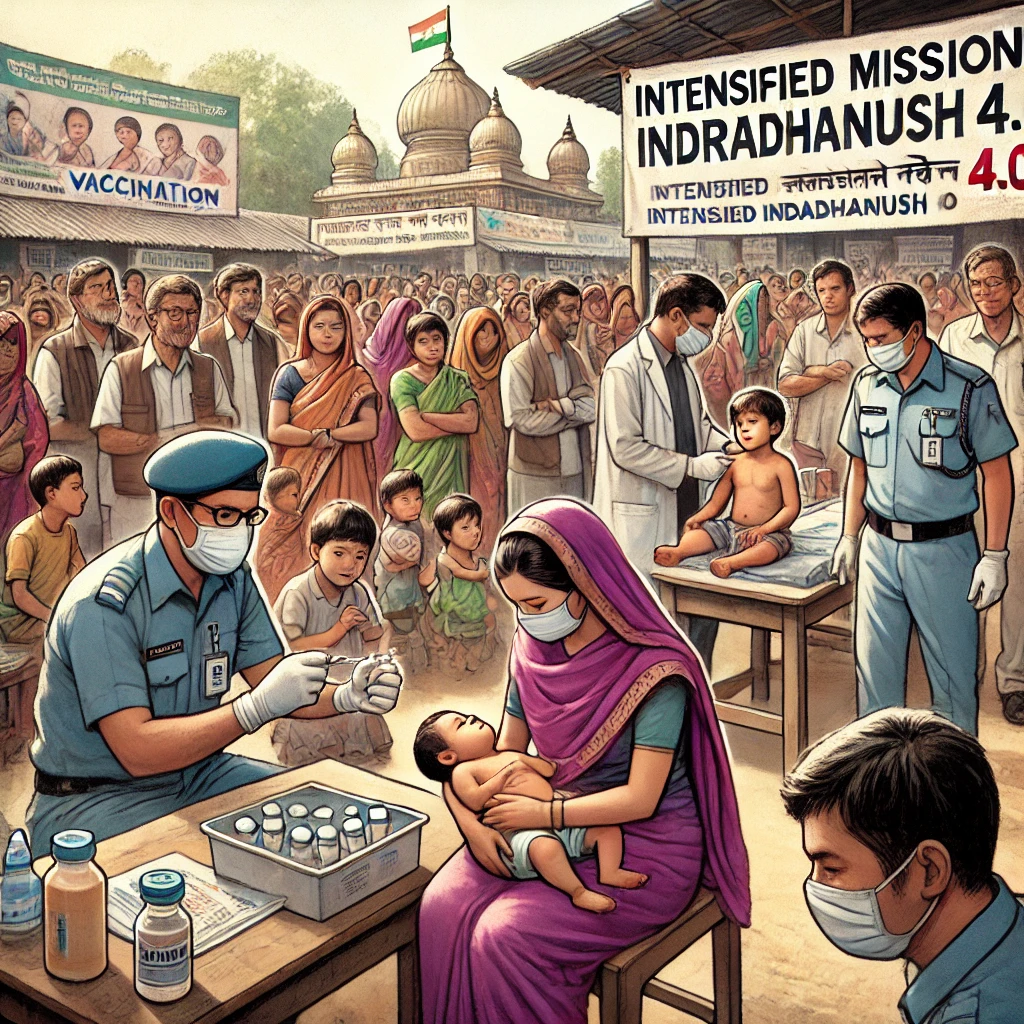The Ministry of Health has recently launched Intensified Mission Indradhanush (IMI) 4.0, aiming to bolster India’s immunization program. India runs the largest immunization campaign globally, targeting over three crore pregnant women and 2.6 crore children every year under the Universal Immunisation Programme (UIP). IMI 4.0 seeks to fill the gaps caused by the COVID-19 pandemic. Thereby, ensuring that routine immunization services reach every unvaccinated or partially vaccinated child and pregnant woman.
- In the first three phases, 28.7 lakh immunisation sessions were conducted, covering 2.1 crore children, of which 55 lakh were fully immunized.
- IMI is supported by 11 other ministries and departments, such as the Ministry of Women and Child Development, Panchayati Raj, the Ministry of Urban Development, and the Ministry of Youth Affairs among others.

What is Mission Indradhanush (MI)?
Mission Indradhanush was launched to accelerate immunisation coverage and ensure that all children and pregnant women receive vaccines. Its primary goal is to achieve 90% full immunization coverage, focusing on 12 vaccine-preventable diseases.
Goals and Targets
Launched in 2015, MI aims to achieve 90% full immunisation coverage. It targets over 89 lakh children who are either unvaccinated or partially vaccinated, making a significant impact on public health.
Diseases Covered
MI targets 12 vaccine-preventable diseases, including diphtheria, whooping cough, tetanus, polio, tuberculosis, hepatitis B, meningitis, pneumonia, Haemophilus influenzae type B, Japanese encephalitis, rotavirus, and measles-rubella. This comprehensive approach ensures broad protection against common and severe diseases.
Flagship Schemes
Mission Indradhanush has been identified as a flagship scheme under the Gram Swaraj Abhiyan and Extended Gram Swaraj Abhiyan. This designation highlights its importance in improving public health outcomes in rural and underserved areas.
Intensified Mission Indradhanush (IMI) and Its Phases
The various phases of Intensified Mission Indradhanush (IMI) have progressively focused on increasing immunization coverage, especially in hard-to-reach areas and among underserved populations.
IMI (2017)
Launched in October 2017, IMI focused on urban areas and aimed to address gaps in immunisation coverage. The goal was to achieve 90% immunisation coverage by December 2018, targeting specific districts and cities.
IMI 2.0 (2019-20)
IMI 2.0 was a nationwide immunisation drive launched in 2019, marking 25 years of the Pulse Polio Programme. It aimed to achieve full immunisation coverage in 272 districts across 27 States, with a target of 90% coverage by 2022.
IMI 3.0 (2021)
Launched in 2021, IMI 3.0 focused on children and pregnant women who missed their vaccine doses during the COVID-19 pandemic. It targeted beneficiaries in migration and hard-to-reach areas to ensure comprehensive immunisation coverage.
What is Intensified Mission Indradhanush (IMI) 4.0?
The Ministry of Health has recently launched Intensified Mission Indradhanush (IMI) 4.0, aimed at reaching unvaccinated and partially vaccinated children and pregnant women. This initiative is a significant step in the Universal Immunization Programme (UIP), aiming to bolster routine immunization efforts that were hindered by the COVID-19 pandemic.
When was IMI 4.0 launched?
The IMI 4.0 was virtually launched by the Ministry of Health to address the gaps in routine immunisation caused by the COVID-19 pandemic. This virtual launch underscores the government’s commitment to ensuring universal immunization, despite the challenges posed by the pandemic.
Scope and Coverage
IMI 4.0 targets unvaccinated and partially vaccinated children up to two years old and pregnant women. This phase will cover 416 districts across 33 States and Union Territories. The initiative aims to enhance vaccination coverage in districts identified based on recent health data and the burden of vaccine-preventable diseases.
Impact of COVID-19
The COVID-19 pandemic significantly slowed routine immunisation services. IMI 4.0 seeks to mitigate these disruptions by ensuring that routine immunisation reaches those who miss out. This initiative will help fill the gaps and make strides toward achieving universal immunisation.
Universal Immunisation Programme (UIP)
The Universal Immunisation Programme (UIP) is a cornerstone of India’s public health strategy, aimed at preventing mortality and morbidity from vaccine-preventable diseases. It covers millions of children and pregnant women annually, making it the largest immunization program globally.
The UIP began as the Expanded Programme of Immunization (EPI) in 1978 and was rebranded as the Universal Immunization Programme in 1985. This evolution reflects the increasing scope and ambition of India’s immunization efforts over the decades.
Purpose and Coverage
The UIP targets 12 vaccine-preventable diseases, aiming to reduce mortality and morbidity among children and pregnant women. Diseases covered include diphtheria, whooping cough, tetanus, polio, tuberculosis, hepatitis B, meningitis, pneumonia, Haemophilus influenza type B, Japanese encephalitis, rotavirus, and measles-rubella.
Conclusion
In conclusion, Intensified Mission Indradhanush 4.0 exemplifies India’s unwavering commitment to universal immunization, addressing gaps exacerbated by the COVID-19 pandemic. By focusing on unvaccinated and partially vaccinated children and pregnant women. This mission not only aims to elevate immunization coverage but also fortify the country’s public health infrastructure. Future civil servants must recognize the transformative impact of such initiatives on shaping a healthier nation.
